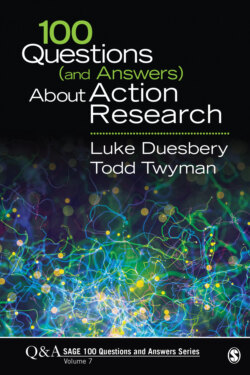Читать книгу 100 Questions (and Answers) About Action Research - Luke Duesbery - Страница 11
На сайте Литреса книга снята с продажи.
Question 2 What Is Action Research, and Where Did It Come From?
ОглавлениеSimply put, action research is a method of systematically examining behavior in an effort to improve practice. The action refers to doing something. The research refers to thinking critically and logically about a problem. Together, they form a powerful combination for making productive change in the workplace.
Action research was originally coined by Kurt Lewin in the late 1940s and has evolved into an umbrella term for any systematic approach bridging research and practice by empowering practitioners with decision-making authority. Basically, action research allows those who live the issue to be the main participant in systematically solving the issue. Action research creates an ability to delve into complex issues in any given situation through formal investigation.
This idea is not new. It was primarily used early on by social scientists in the United States who explored issues in business and communities (i.e., wage disparity, sociocultural discrimination). Noted American educators such as Hilda Taba and John Dewey early in the 20th century used action research principles as tools for teachers to link what they were seeing and doing in their classrooms to what more controlled research was reporting, but in a more applicable and meaningful way. And while action research fell out of favor in the United States with ivory tower positivists who believed that only experts conducted valuable research to answer universal “truths,” teachers in Great Britain continued to use action research well into the 1960s. And so, while its roots lay in a strong qualitative tradition, action research has changed and grown over time to be more aptly called a mixed-method approach, borrowing from both qualitative and quantitative traditions.
In the 1970s, arguably as an extension of Paulo Freire’s anti-colonial view of education, this “new” theoretical approach, combined with the narrowing rift between seemingly conflicting qualitative and quantitative research traditions in education, provided necessary pushback to positivist researchers. In its current iteration, considering the fact that practitioners are critical pieces in reform, action research is looked upon as a piece of workplace development and individual professional development.
Other popular names for action research are participatory action research, practical inquiry, teacher research, practitioner research, reflective inquiry, inquiry-oriented teaching, or other similarly phrased compound words including synonyms for research and practice. And while the actual label may be confusing, at the heart of the matter is the fact that we are all naturally researchers, perhaps without knowing it. We often try out new strategies and make changes and modifications based on “how it worked” in our daily lives. Action research formalizes this intuition.
More questions? See questions 4, 7, and 21.
